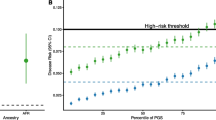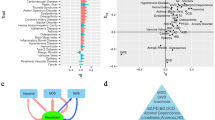Abstract
Large numbers of quantitative trait loci (QTLs) for blood pressure (BP) exist and have long been thought to function by accumulating their individual miniscule effects. Recent experimental evidence in the functional biology of BP control has tested this intuitive assumption. A new paradigm has emerged that BP is biologically determined in modularity by multiple QTLs. Functionally, when a master regulator is taken out, distinct epistatic modules organize biological ‘blocks’ into a genetic architecture, and serve as basic functional cores from which numerous QTLs act together to physiologically formulate BP. An epistatic module refers to the grouping of QTLs that perform their functions epistatically to one another and influence BP as a group. The modularity mechanism framework indicates that BP as a quantitatively-measured trait is not cumulatively determined and implies that the QTLs in the same epistatic module may participate in the same pathway leading to the BP control, and the QTLs from separate epistatic modules may act in divergent but parallel pathways. This mechanistic conceptualization and subsequent validations synergize with anticipated demands from current human epidemiological studies, since the outcome from them primarily implicates single nucleotide polymorphisms with unknown functions. Eventually, functional understandings of the human results have to be realized by their pathogenic directionality and mechanisms biologically controlling BP.

Similar content being viewed by others
References
Rapp JP, Deng AY. Detection and positional cloning of blood pressure quantitative trait loci: is it possible? Hypertension. 1995;25:1121–8.
Deng AY. Positional cloning of quantitative trait loci for blood pressure: how close are we?: a critical perspective. Hypertension. 2007;49:740–7.
Evangelou E, Warren HR, Mosen-Ansorena D, Mifsud B, Pazoki R, Gao H, et al. Genetic analysis of over 1 million people identifies 535 new loci associated with blood pressure traits. Nat Genet. 2018;50:1412–25.
Boyle EA, Li YI, Pritchard JK. An expanded view of complex traits: from polygenic to omnigenic. Cell. 2017;169:1177–86.
Deng AY, deBlois D, Laporte SA, Gelinas D, Tardif J-C, Thorin E, et al. Novel pathogenesis of hypertension and diastolic dysfunction caused by M3R (Muscarinic Cholinergic 3 Receptor) signaling. Hypertension. 2018;72:755–64.
Chauvet C, Crespo K, Menard A, Roy J, Deng AY. Modularization and epistatic hierarchy determine homeostatic actions of multiple blood pressure quantitative trait loci. Hum Mol Genet. 2013;22:4451–9.
Crespo K, Menard A, Deng AY. Hypertension suppression, not a cumulative thrust of quantitative trait loci, predisposes blood pressure homeostasis to normotension. Circ: Cardiovas Genet. 2015;8:610–7.
Harrap SB, Morris BJ. Blood pressure genetics just don’t add up. Circ Cardiovasc Genet. 2015;8:541–3.
Deng AY. Genetic mechanisms of polygenic hypertension: fundamental insights from experimental models. J Hypertens. 2015;33:669–80.
Bateson W. Facts limiting the theory of heredity. Science. 1907;26:649–60.
Mackay TFC. Epistasis and quantitative traits: using model organisms to study gene-gene interactions. Nat Rev Genet. 2014;15:22–33.
Rapp JP, Garret MR, Deng AY. Construction of a double congenic strain to prove an epistatic interaction on blood pressure between rat chromosomes 2 and 10. J Clin Investig. 1998;101:1591–5.
Palijan A, Dutil J, Deng AY. Quantitative trait loci with opposing blood pressure effects demonstrating epistasis on Dahl rat chromosome 3. Physiol Genomics. 2003;15:1–8.
Charron S, Duong C, Menard A, Roy J, Eliopoulos V, lambert R, et al. Epistasis, not numbers, regulates functions of clustered Dahl rat quantitative trait loci applicable to human hypertension. Hypertension. 2005;46:1300–8.
Charron S, lambert R, Eliopoulos V, Duong C, Menard A, Roy J, et al. A loss of genome buffering capacity of Dahl salt-sensitive model to modulate blood pressure as a cause of hypertension. Hum Mol Genet. 2005;14:3877–84.
Deng AY. Genetic basis of polygenic hypertension. Hum Mol Genet. 2007;16:R195–202.
Avery L, Wasserman S. Ordering gene function: the interpretation of epistasis in regulatory hierarchies. Trends Genet. 1992;8:312–6.
Hodgkin J. Sex determination compared in Drosophila and Caenorhabditis. Nature. 1990;344:721–8.
Deng AY, Huot-Marchard J-É, deBlois D, Thorin E, Chauvet C, Menard A. Functional dosage of muscarinic cholinergic receptor 3 signalling, not the gene dose, determines its hypertension pathogenesis. Can J Cardiol. 2019;35:661–70.
Consortium IB. Genetic variants in novel pathways influence blood pressure and cardiovascular disease risk. Nature. 2011;478:103–9.
Ojeda NB, Grigore D, Alexander BT. Role of fetal programming in the development of hypertension. Future Cardiol. 2008;4:163–74.
Consortium W. Genome-wide association study of 14,000 cases of seven common diseases and 3,000 shared controls. Nature. 2007;447:661–78.
White CR, Seymour RS. The role of gravity in the evolution of mammalian blood pressure. Evolution. 2014;68:901–8.
Flint J, Mackay TF. Genetic architecture of quantitative traits in mice, flies, and humans. Genome Res. 2009;19:723–33.
Boyden LM, Choi M, Choate KA, Nelson-Williams CJ, Farhi A, Toka HR, et al. Mutations in kelch-like 3 and cullin 3 cause hypertension and electrolyte abnormalities. Nature. 2012;482:98–102.
Ben-Menahem A. Historical encyclopedia of natural and mathematical sciences. Springer, Berlin, Heidelberg: Springer Science & Business Media; 2009.
Rapp JP, Joe B. Do epistatic modules exist in the genetic control of blood pressure in Dahl rats? A critical perspective. Physiol Genomics. 2013;45:1193–5.
Cheng X, Waghulde H, Mell B, Morgan EE, Pruett-Miller SM, Joe B. Positional cloning of quantitative trait nucleotides for blood pressure and cardiac QT-interval by targeted CRISPR/Cas9 editing of a novel long non-coding RNA. PLOS Genet. 2017;13:e1006961.
Cowley AW. Chrm3 Gene and M3 muscarinic receptors contribute to salt-sensitive hypertension, but now a physiological puzzle. Hypertension. 2018;72:588–91.
Crespo K, Ménard A, Deng AY. Retinoblastoma-associated protein 140 as a candidate for a novel etiological gene to hypertension. Clin Exp Hypertens. 2016;38:533–40.
Deng AY, Chauvet C, Ménard A. Alterations in fibronectin type III domain containing 1 protein gene are associated with hypertension. PLoS One. 2016;11:e0151399.
Chauvet C, Menard A, Deng AY. Two candidate genes for two quantitative trait loci epistatically attenuate hypertension in a novel pathway. J Hypertens. 2015;33:1791–801.
Gopalakrishnan K, Kumarasamy S, Abdul-Majeed S, Kalinoski AL, Morgan EE, Gohara AF, et al. Targeted disruption of Adamts16 gene in a rat genetic model of hypertension. Proc Nat Acad Sci. 2012;109:20555–9.
Acknowledgements
This work was supported by operating grants from Canadian Institute of Health Research and Heart and Stroke Foundation of Canada.
Author information
Authors and Affiliations
Corresponding author
Ethics declarations
Conflict of interest
The author declares that he has no conflict of interest.
Additional information
Publisher’s note Springer Nature remains neutral with regard to jurisdictional claims in published maps and institutional affiliations.
Rights and permissions
About this article
Cite this article
Deng, A.Y. Modularity/non-cumulativity of quantitative trait loci on blood pressure. J Hum Hypertens 34, 432–439 (2020). https://doi.org/10.1038/s41371-020-0319-3
Received:
Revised:
Accepted:
Published:
Issue Date:
DOI: https://doi.org/10.1038/s41371-020-0319-3
- Springer Nature Limited




